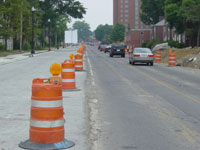The RCC was particularly useful under the difficult traffic conditions. The city required a flexural strength of 400 pounds per square inch (psi) before traffic could be resumed on the new pavement, and this was usually accomplished within 24 to 48 hours after RCC construction. Because of its early stability, the RCC could support even earlier traffic in intersections and areas around businesses that needed uninterrupted access.
Bob Thompson, an engineer with Savko, was very pleased with the RCC construction in such a complicated project.
"We were confident that we could build an excellent final product, but we were really pleased with the RCC construction process under busy traffic conditions in an urban area,” Thompson said.

The Lane Avenue pavement design called for eight inches of roller-compacted concrete, surfaced with three inches of asphalt. Savko produced the concrete for the project at their pug mill located near downtown Columbus. The mix included 450 pounds of cement and 50 pounds of fly ash per cubic yard. Quality control testing produced results averaging 7,000 psi compressive strength in 28 days.
Because the RCC was being evaluated as a new product, the city requested a warranty for the Lane Avenue project.
Martin Savko, vice president of Savko & Sons, had no hesitation about providing a five-year warranty.
“We know that RCC is a tough, durable concrete that typically has a very long service life with little maintenance,” Savko said, “A five-year warranty is no problem for us.”
The reason that the city selected RCC for the Lane Avenue project was excellent experience in previous projects built in Columbus since 2001.
“We have built about 28 RCC projects, with 13 more already planned. Our construction test data and annual condition surveys have been very positive” said Dick Cummins, an engineer with the City of Columbus, who developed the city’s RCC specification when the process was first introduced to the area.
Most of the completed projects in the Columbus area have been in residential areas, where developers liked the ability to have an all-weather RCC platform to work from. The RCC could be placed early, and could easily handle the abuse from the construction equipment and truck traffic (which causes most of the severe damage to residential streets). With residential street re-construction, another big advantage of RCC was the ability to speed up the project, and reduce the inconvenience to local residents. Residents can usually drive on the RCC the same day it is constructed.